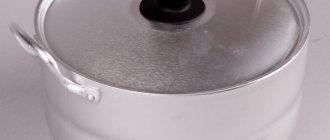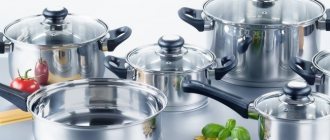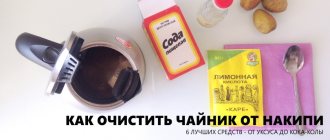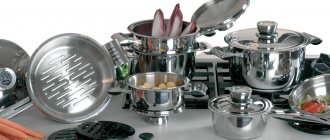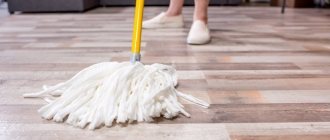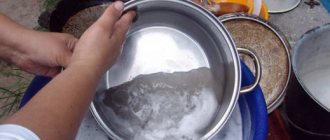Dishes made from this metal look beautiful, are not subject to oxidation in water, and are resistant to wear and corrosion.
To avoid the formation of stains on the surface of stainless steel, you need to follow the rules of caring for it and choose the right detergents.
We'll talk more about cleaning products for stainless steel cookware in the article.
Features of stainless steel
It’s not for nothing that housewives choose stainless steel saucepans, pots, and kettles. Cookware made from high-quality alloy (chrome, nickel, steel) has advantages over products made from other materials.
Corrosion resistance
Chromium, which is part of the alloy, forms a film on the surface that protects the metal from corrosion. The anti-corrosion layer is constantly updated.
During cooking, the material does not interact with moisture, alkalis, or acids. He is not afraid of dishwashing detergents and food acids.
Strength and Durability
The alloy (X18H10) is highly durable. Dishes made from it are not subject to deformation. The steel surface is not afraid of mechanical damage.
Heat resistance
Stainless steel cookware is designed for a wide range of temperatures. It can be safely placed in the freezer or oven.
Environmental friendliness
There is no place for harmful microorganisms on a smooth polished surface. Food cooked in stainless steel containers does not contain harmful impurities, there are no foreign tastes or odors.
Versatility
Stainless steel models are available for gas, induction and electric stoves. The cooking surface of the latter can be of any type:
- burner pancakes;
- Hi-light;
- glass ceramics.
Flawless appearance
Keeping your products clean is easy. They always look impeccable and fit harmoniously into any interior.
Possible contaminations and their causes
During operation, the cookware comes into contact with food, water, fats, and acids. On the surface, in addition to food, other types of contaminants are formed.
Nagar
During cooking, fat splashes onto the internal and external surfaces of the cookware. First they create a thin yellow film. It's sticky and durable. If it is not removed, carbon deposits will form on the surface. It is a dark, thick crust.
See also
The best ways to care for and clean swimming pools, a review of popular vacuum cleaners
"Rainbow" on the bottom and walls
Rainbow stains appear on the bottom and walls if an empty pan is overheated. Under the influence of high temperatures, the protective film on the steel surface thickens. It creates the rainbow effect. The operational properties of the product are preserved.
Scale
Limescale appears on the bottom of a kettle or pan. It means the water is hard. It contains mineral salts. The color of the plaque depends on what minerals are dissolved in the water. It can be white, gray, red.
Secrets of care
Caring for stainless steel cookware is easy. There are three rules that must be followed during operation.
Regular cleansing
After finishing cooking, do not delay in washing pots and saucepans. Dried traces of food on the walls are much more difficult to wash off than fresh ones.
Difficult stains need to be soaked. Scrub using special sponges and gels.
Delicate wash
It is better not to use cleaning products containing abrasive and aggressive substances. The use of soft gels extends the life of dishes.
Perfect dryness
Do not put a wet pan in the cupboard. After each wash, you need to wipe it dry with a towel. If you follow this rule, there will never be streaks on the bottom and walls.
Where can I polish?
In order for the surface of the alloy to be beautiful and smooth, you need to polish the stainless steel. Nowadays, there are many companies whose specialization is this particular procedure; they put in order various products made from this alloy. But it turns out that you can polish stainless steel at home.
Of course, if you need better quality work, it is better to seek help from specialists. For example, a polished square stainless steel pipe will look much more impressive after factory processing than after home processing.
Any company that specializes in polishing will easily perform this procedure.
Principles of cleansing at home
Tips for caring for stainless steel are very simple. They are easy to follow.
What not to use
List of products and devices that should not be used when using stainless steel cookware:
- Dishwasher;
- metal sponge;
- a cleaner containing abrasive components.
How to use baking soda and salt
Salt and soda are essential care products for stainless steel cookware. The principle of their use is simple:
- the product is washed;
- apply soda, salt or a mixture thereof to the contaminated area;
- rub the powder in a circular motion.
After cleaning, the item is rinsed with water and dried with a towel.
Timeliness
Regular cleaning of stainless steel pans eliminates the appearance of old stains. It takes little time to remove fresh stains.
To avoid divorces
After each wash, wipe the dishes dry with a kitchen towel. There are no streaks on a clean, dry surface.
General recommendations on how to clean the stove
First of all, you need to remove all unnecessary items. Depending on the gas or electrical structure of the equipment, you need to turn off the gas or the stove itself.
It is best to clean the controls and burners by removing them from their sockets.
To clean stainless steel without harming your hands, you need to stock up on rubber gloves. It is possible to safely clean stainless steel only by gradually increasing the concentration with the obligatory alternation of water rinses.
It is extremely dangerous to mix chemicals. Experiments may result in the formation of toxic gases and stubborn stains.
This is exactly how many overly energetic housewives, trying to clean the stainless steel hob as best as possible, create new problems for themselves.
Cleaning Products Review
You can buy the product in the household chemicals department. A brief overview of the best products for stainless steel will help you make the right choice.
"Dafor"
Spray removes heavy dirt. Spray and leave for 1-2 minutes. Clean with a damp sponge. Polish with a dry cloth.
"Shine of Steel"
This is a cream. It's thick. Contains a mild abrasive substance. Designed for cleaning metal surfaces from limescale and burnt food. It can be used as a polishing agent.
"Selena"
Liquid, well-foaming product. Removes fat from the surface. It can be used daily.
"Shumanit"
Alkaline cleaner. Release forms: powder, spray, gel. They can clean old stains.
See also
How to clean an air conditioner with your own hands at home, the best products
Luxus
German product for daily care of dishes. Concentrated. Does not contain alkali.
Help
Gel that works in cold water. Foams and removes all types of dirt.
Delu
Liquid cleaner and polisher for metal surfaces.
Dr. Beckmanm
The spray can be used to clean any stainless steel product. Contains no chlorine or abrasives. The product removes grease, stains, stains. It is used for polishing.
Fresh
Concentrated liquid for cleaning dishes. Works well in cold and hot water.
Traditional methods
All recipes are very simple. They are based on the properties of natural substances that are found in every kitchen.
Boiling
The recipe was invented by housewives during Soviet times. At that time, there were practically no household chemicals in stores. Everyone used improvised means.
Inside
The cleaning solution is poured into a stainless steel container. Place it on the burner, heat the liquid to a boil, and simmer over low heat for at least 2 hours. Leave to cool. The solution is drained. Rinse the pan and wipe dry.
Outside
Take a large enamel basin or tank. Fill it with cleaning solution. Place it on the stove. Stainless steel objects are lowered into it. The liquid should completely cover them. The dishes are boiled for at least 2 hours. Remove from the pan when the solution has cooled. All items are washed under running water and wiped.
How to prepare the composition
Take the required volume of water. The working solution is prepared based on the following proportions:
- water - 5 l;
- stationery glue - 100 ml;
- soda - 500 g.
Anti-carbon pastes
There is always a product in the kitchen that can be used to scrub off burnt milk and porridge.
Ground activated carbon
Remains of burnt porridge are quickly removed with activated carbon. The tablets are crushed. Powder is poured onto the bottom of the pan. Pour water into it. After 15 minutes, the carbon deposits are easily wiped off.
Ground coffee beans
Thrifty housewives do not throw away filters with spent coffee. They use grounds instead of body scrub and metal pan cleaner. Apply it to the contaminated area, rub with a sponge, leave for 10 minutes, and rinse with water.
Liquids from white deposits and scale
Scale forms in the kettle, and a white coating forms on the walls of the pan. The cause of deposits is hard water. There are 3 products that can easily cope with this type of pollution.
Vinegar
Pour 1 liter of water and 100 ml of apple cider vinegar into the kettle. Boil the solution several times. The plaque is wiped off with a sponge.
Citric acid solution
Fill the kettle ⅔ full with water. Add 20 g of citric acid. Boil. Allow the water to cool and boil one more time. Plaque removal begins after a few hours. Scrub with a sponge or brush.
Coca Cola
Fill ⅔ of the pan with the drink. Bring it to a boil. Leave to cool. The plaque is wiped off after 30 minutes. Use a brush or sponge.
See also
TOP 16 ways to quickly clean a grill grate with your own hands
How to treat cutlery
Spoons, forks and knives lose their shine over time and contact with food. Restore your radiance using affordable products.
Vinegar or lemon juice
9% vinegar and lemon juice are equally effective. They are applied to cutlery with a flannel napkin. After 30 minutes, rinse and wipe dry.
Ammonia
The lost shine is restored with ammonia. It is added to water - 1 tsp. l/l. The previously washed stainless steel cutlery is lowered into the basin. After 5-10 minutes, rinse spoons, forks, and knives and wipe dry with a kitchen towel.
Non-abrasive toothpaste or powder
The products remove the yellow film and polish the surface. A small amount of paste is applied to the surface and rubbed with a napkin. After rinsing, wipe and rub until shiny with a towel.
Mustard powder
Mustard powder has cleaning properties. It is used to make paste. Stirring constantly, add warm water. The mixture is applied with a brush to the tarnished surface of the stainless steel.
He rubs it with little effort. The mustard is washed off with water and dishwashing gel. The gloss is induced with ammonia.
Adding shine
It's easy to restore the shine to stainless steel pans. It takes 10-15 minutes to polish one product.
Vinegar
Wear gloves when working with table vinegar. It quickly removes all types of contaminants. Apply it to a soft sponge and wipe tarnished metal surfaces. Durable films of old fat are difficult to remove. To enhance the cleaning effect, add lemon juice to the vinegar. After the procedure, the dishes are rinsed.
Lemon juice solution
Squeeze the juice from half a lemon. For 1 liter of water you need only 1 tbsp. l. Moisten a sponge with the resulting solution and wipe the pan with it inside and out. Rinse it with water and wipe dry with a towel.
Steel Polish
No need to run to the store. An effective polish is available in the kitchen.
Raw potatoes
To make the kettle shine like new, wash the potatoes and cut them into 2 halves. Rub them on a steel surface. Use the same method to shine the pots.
Main stages of the process
The process takes place in several stages. First you need to do some rough cleaning. Next comes a wheel with a fiber base and an angle grinder. But this procedure can be skipped provided that the surface of the product is already quite smooth.
Grinding wheels come next. The surface must be processed several times, and each time the size of the abrasive should decrease.
If such circles are not available, then you can easily make them yourself. To do this, you can use a felt circle or felt. You need to apply wood glue to it with a spatula, and then rub it over the abrasive chips.
This operation will make the steel surface perfectly smooth. Under no circumstances should any roughness remain. After all, after polishing it will be much more difficult to seal them.
The next step is to apply polishing paste and a felt wheel. Here it is better to consult a specialist, since a specific brand of alloy requires a specific paste. Of course, it is best to use diamond, the grit of which is suitable for the metal intended for processing. Final polishing is carried out until there are no visible flaws left. A polished stainless steel pipe should look just perfect.
